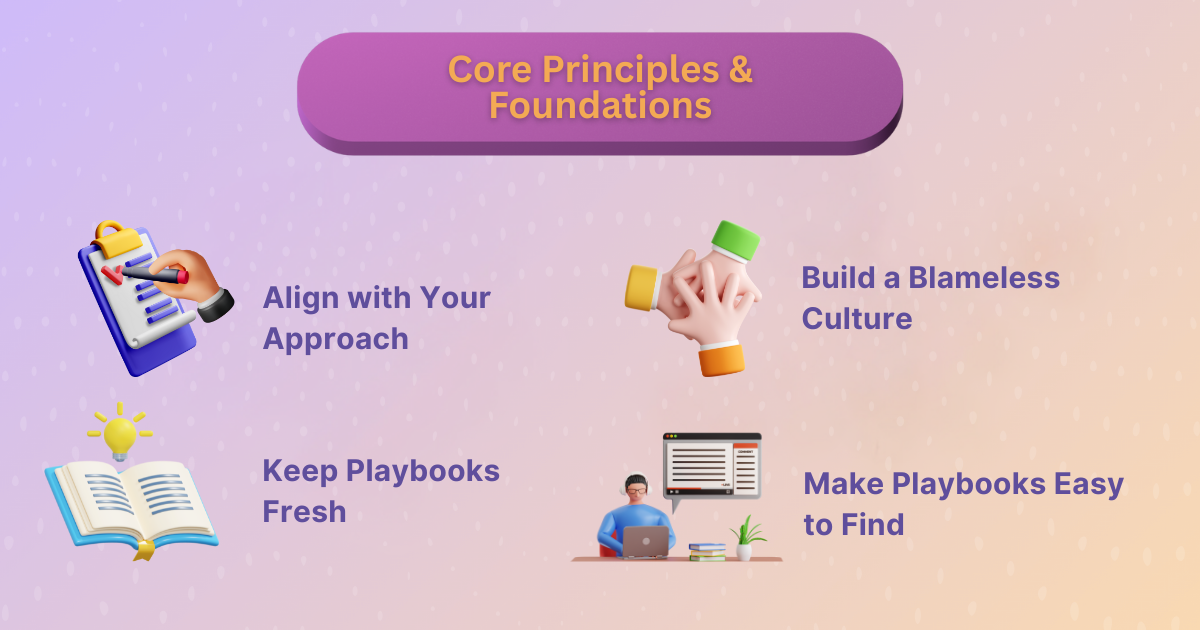When an incident strikes, chaos can be merciless. The difference between panic and precision lies in preparation. Incident response playbooks are not just static documents; they are the codified wisdom of a team distilled into actions that bring order when systems falter. To create and use them effectively, teams must design playbooks that are actionable, accessible, and continuously improved through real-world feedback. They are the calm voice in the storm, the map that guides responders through uncertainty with clarity and confidence.
Key Takeaways
- Incident response playbooks enhance coordination by providing clear, step-by-step guidance that minimizes confusion during high-pressure events.
- Effective playbooks evolve continuously, using feedback from real incidents to refine workflows and strengthen response precision.
- Automation integration boosts efficiency, allowing responders to act faster through pre-built triggers and tool connections.
- Consistent documentation ensures accountability, creating audit-ready records that support compliance and post-incident learning.
- Strong playbook governance maintains reliability, with defined ownership, version control, and regular reviews keeping processes accurate and current.
Why Incident Response Playbooks Matter
From Chaos to Consistency
The first few minutes of an incident define everything that follows. A clear playbook replaces scattered improvisation with consistency. It helps responders act in harmony, even under pressure, ensuring that every critical step is accounted for. The real magic of a playbook is not in the text but in how it transforms confusion into cohesion.
Playbooks vs Runbooks vs Incident Response Plans
Playbooks, runbooks, and response plans often get tangled in conversation, but each serves a distinct role.
Here’s how they differ:
- Response Plan: The overarching blueprint that defines who does what and when. It sets strategy, scope, and accountability.
- Runbook: A set of precise, repeatable technical steps, ideal for tasks that require consistency and minimal interpretation.
- Playbook: The bridge between the two. It translates strategic intent into actionable workflows and guided decisions.
In essence, the playbook guides decision-making while leaving room for human judgment. It serves as the middle ground, structured yet flexible, helping responders adapt when reality strays from expectation.
The ROI: Reduced Downtime, Faster Decision-Making, Better Learning Loops
A well-built playbook accelerates mean time to respond and recover. When responders know where to look, who to call, and what to check first, they act faster and more confidently. Over time, these efficiencies compound. The organization learns, iterates, and evolves, transforming every incident into an opportunity for refinement.
Search, Audit Engines & Regulations: Why Tooling and Documentation Matter
In a landscape of compliance and audit demands, documentation is no longer optional. Organizations today must be ready to demonstrate structured, repeatable processes whenever auditors or regulators come calling.
Key points to emphasize:
- Evidence of Process: Regulators and auditors often expect detailed records of every incident, from escalation to resolution.
- Traceability: Playbooks ensure every action, decision, and follow-up step is tracked and defensible.
- Accountability: Transparent documentation builds confidence internally and externally.
- Resilience: Beyond compliance, clear documentation strengthens your team’s ability to recover and adapt after every incident.
By combining compliance requirements with operational discipline, playbooks transform mandatory documentation into a strategic advantage for growth and trust.
Core Principles & Foundations

Align with Your Approach
A playbook should not exist in isolation. It must reflect the values and risk appetite of your organization. Whether your culture leans toward innovation or caution, your playbook should embody that rhythm, balancing precision with pragmatism.
Build a Blameless Culture
Responders cannot think clearly if they fear repercussions. A blameless culture empowers individuals to act decisively. When people know they are trusted, they make faster, better decisions. The best playbooks encourage autonomy rather than micromanagement.
Keep Playbooks Fresh
A static playbook is a dead one. Regular versioning and reviews keep it alive and relevant. Each incident is a stress test that reveals flaws in documentation, assumptions, or communication. Gather feedback after every major event to make sure your playbook continues to evolve.
Make Playbooks Easy to Find
During an outage, no one should waste time searching for guidance. Playbooks must be visible within your incident management system, just a click away. Keep structure and wording simple so responders can act quickly without scrolling through walls of text.
Incident Response Lifecycle & Frameworks (Context)
Frameworks and Fit
Industry frameworks like NIST and SANS offer a high-level blueprint for response. Playbooks turn those frameworks into execution. They take theory and operationalize it, transforming abstract stages into precise tasks your team can perform.
Response Phases
Every phase has its rhythm. Preparation builds the muscle. Detection triggers awareness. Triage and containment control impact. Recovery restores service, and lessons learned ensure evolution. A playbook provides the choreography connecting these phases seamlessly.
Layering Playbooks
Not all incidents deserve the same level of response. Layer playbooks by severity: SEV3 for minor issues, SEV0 for existential threats. Similarly, tailor by domain, security, infrastructure, and application, so that responders engage the right context and resources.
Workflow Mapping
Visual swimlanes clarify ownership. When each function knows its boundaries and intersections, confusion disappears. Visualizing the process helps responders see the bigger picture, making coordination intuitive rather than reactive.
Elements / Ingredients of a Strong Incident Response Playbook

Incident Classification & Severity Taxonomy
Define severity levels clearly and list their triggers. This ensures teams can gauge impact quickly and prioritize effectively. With standardized classification, confusion drops and coordination improves across teams.
Trigger Conditions & Initiation Criteria
Each playbook must specify what conditions activate it. Clarity ensures responders know exactly when to act and what signals to trust. By defining precise initiation points, teams avoid both hesitation and unnecessary escalations.
Roles & Responsibilities
Define roles explicitly: Incident Commander, Scribe, Subject Matter Experts, Communications Lead. Clear ownership eliminates confusion and speeds up decision-making. When everyone knows their part, collaboration becomes natural and efficient.
Escalation Paths and Thresholds
Map escalation paths clearly so responders know who to contact and when. Defined thresholds prevent over-escalation while ensuring critical issues get prompt attention. This structure reduces stress, avoids burnout, and accelerates recovery.
Communication Protocols & Templates
Playbooks should include ready-to-use templates for updates and notifications. Consistent communication prevents confusion and builds confidence during chaos. It also helps maintain transparency across internal teams and external stakeholders.
Checklists and Decision Trees
Checklists keep responders grounded in high-pressure moments. Decision trees introduce adaptability, allowing teams to pivot without losing structure. Together, they create balance between discipline and flexibility.
Integration with Tooling & Automation
Modern playbooks connect directly with the tools teams already use. Automation triggers the right playbook, posts updates, and pulls key data into incident channels. This eliminates manual friction and lets responders focus on solving the issue, not managing the process.
Data Capture & Timeline Requirements
Every action during a response should be logged automatically. This creates a reliable record for post-incident reviews and training. A complete timeline also strengthens accountability and enables deeper learning.
Safety Nets & Fallback Procedures
Even experienced teams can make mistakes under pressure. Build in recovery checkpoints that allow responders to verify or reverse actions safely. These safety nets ensure incidents remain contained and controlled.
Post-Incident / Retrospective Guidance
Each playbook should close with clear reflection prompts. Encourage teams to document what worked, what didn’t, and what can improve next time. Continuous reflection transforms experience into organizational growth.
Step-by-Step: How to Build a Playbook from Scratch

Step 1: Identify Common Incident Types
Analyze past incidents and detect patterns. Build playbooks for recurring ones first, the 20% that cause 80% of disruptions. Starting small ensures immediate value and continuous refinement.
Step 2: Map Stakeholders and Escalation Chains
Visualize dependencies and relationships. Identify responders, decision-makers, and escalation tiers early. This foresight prevents confusion and shortens response time.
Step 3: Draft Trigger Events and Decision Logic
Document the conditions that activate a response. Define decision points clearly so responders know when to act and how to adapt. This minimizes uncertainty in high-pressure situations.
Step 4: Build Checklists and Flows
Structure your playbook into easy-to-follow steps. Use action verbs, concise phrasing, and intuitive sequencing. A well-designed flow transforms complexity into confident execution.
Step 5: Integrate Automations
Automations lighten the load for responders. Whether it’s fetching logs, tagging stakeholders, or updating dashboards, systems should handle repetitive tasks. Automation ensures speed and consistency.
Step 6: Simulate and Run Drills
Practice bridges the gap between documentation and action. Simulate real incidents to test your playbooks and uncover gaps. Regular drills turn responders into instinctive problem-solvers.
Step 7: Publish and Train Responders
Make the playbook visible and accessible across teams. Walk responders through it until it becomes second nature. Familiarity builds confidence and ensures smoother execution.
Step 8: Collect Feedback and Iterate
After each incident, gather feedback while details are fresh. Update instructions and workflows based on lessons learned. Iteration keeps the playbook relevant and sharp.
Step 9: Expand, Specialize, or Refactor Over Time
As your systems evolve, new incident types will appear. Expand and specialize your playbooks to cover emerging scenarios. Keep them modular to scale effectively without losing simplicity.
Best Practices & Pitfalls to Avoid
- Keep Actions Clear: Responders need clarity, not prose. Each step should describe what to do, not what to consider.
- Avoid Too Much Detail: Excessive detail overwhelms responders. Focus on key steps and link to deeper documentation only when necessary.
- Review Regularly: Schedule reviews to remove stale content. Outdated instructions erode trust and slow response.
- Encourage Collaboration: Avoid silos by fostering shared ownership across engineering, operations, and security.
- Add Context: Explain why each step matters. Context builds intuition and adaptability.
- Document Everything: Logging and auditing every action supports learning and compliance. Automate whenever possible to reduce manual effort.
- Train and Test Often: Regular drills turn panic into precision. Practice strengthens response reflexes.
- Keep It Modular: Smaller, focused playbooks are easier to maintain and train on than one large monolithic document.
Tools, Automation & Integration
Incident Management Tools and Playbook Features
Centralized tools connect people, processes, and automation. They unify communication, making it easier for teams to coordinate in real time. Integration ensures that no step is forgotten, and no update slips through during a crisis.
Orchestration Platforms and Scriptable Playbooks
Orchestration adds intelligence to execution. It allows playbooks to adapt dynamically based on event data. With scriptable logic, teams can automate complex tasks and trigger specific actions automatically, saving time and reducing errors.
Alerts and Automatic Playbook Invocation
Automation can instantly launch the correct playbook when an alert fires. Responders enter a prepared space where context, instructions, and metrics are already available. This rapid activation ensures incidents are addressed at the first sign of trouble.
Dashboards, Monitoring Integrations, and Auto-Attachments
Dashboards offer real-time visibility into system health and incident status. Integrating monitoring tools and logs directly into response channels saves critical minutes during diagnosis. Auto-attachments keep responders informed without leaving the workspace.
Version Control and Changelogs
Maintaining historical versions of playbooks preserves institutional knowledge. Each update and change is tracked for transparency and accountability. This structure builds trust, encourages experimentation, and ensures continuity when teams evolve.
Metrics and KPIs
Tracking measurable outcomes provides insight into efficiency and reliability. Metrics like mean time to detect (MTTD), mean time to respond (MTTR), and playbook utilization reveal where processes excel or need improvement. Data-driven insights guide decisions that improve future incident response.
Postmortem, Feedback Loops & Continuous Improvement
Structure of Post-Incident Review
- Understand, Don’t Blame: A good postmortem focuses on understanding rather than assigning fault. It highlights how events unfolded and what influenced key decisions.
- Map the Timeline: Identify the sequence of actions, from detection to resolution, and analyze the critical moments that shaped the outcome.
- Document Insights: Capture emotional tone, decision context, and lessons learned to create a well-rounded understanding of the incident.
Feeding Learnings Back into the Playbook
- Update Promptly: Each review should lead to playbook improvements. Update steps, clarify gaps, and enhance automation logic as needed.
- Close the Loop: When inefficiencies are identified, implement changes before the next incident. Fast iteration keeps processes sharp.
- Promote Learning Culture: Encourage teams to treat postmortems as growth opportunities rather than audits.
Monitoring Playbook Effectiveness
- Track Usage: Measure which playbooks were triggered and how often. Understanding engagement highlights which areas need refinement.
- Identify Gaps: Note skipped steps or incomplete sections to spot where confusion or inefficiency occurs.
- Refine Continuously: Use this data to streamline workflows and ensure your playbooks evolve alongside your systems.
Version Control, Deprecation, and Archival
- Retire Gracefully: Remove outdated playbooks to avoid confusion and clutter. Retiring content ensures responders always use accurate guidance.
- Archive for Insight: Keep historical playbooks as reference materials for training and long-term analysis.
- Focus Active Efforts: Maintain only relevant, up-to-date playbooks to reduce noise during incidents.
Quarterly Audits and Gameday Exercises
- Review Regularly: Schedule quarterly audits to verify relevance, accuracy, and completeness.
- Simulate Scenarios: Conduct gameday exercises to test playbooks under realistic conditions.
- Validate Performance: Use these sessions to confirm that processes still hold up against evolving architectures and new challenges.
Scaling & Governance

- Playbook Hierarchies: Structure your library into global, domain-specific, and team-specific layers. This approach ensures consistency while maintaining flexibility for different teams.
- Governance, Approval, and Review: Assign clear ownership for each playbook. Regular peer reviews and audits keep documentation accurate, credible, and up to date.
- Access Control and Permissions: Limit editing rights to maintain integrity. Define roles carefully so responders can access what they need without confusion.
- Cross-Team Alignment: Standardize terminology, metrics, and response triggers across departments. This alignment enhances collaboration and reduces friction during multi-team incidents.
- Change Management: Keep updates intentional, not bureaucratic. Always document why a change was made to preserve context and knowledge for future responders.
Moving from Reactive to Resilient: The Path Forward
Playbooks are more than checklists, they embody the mindset of resilience, precision, and shared learning. When built thoughtfully, they become living systems that guide your team through uncertainty and growth. Perfection isn’t the goal; start with your most common incidents and iterate until your documentation reflects your team’s instincts. Templates help you start quickly but should never limit creativity, adapt them, personalize them, and make them your own.
At Rootly, we’ve seen how the right playbook transforms response from reactive chaos to proactive mastery, empowering teams to move with clarity and confidence. As your knowledge evolves alongside your infrastructure, the goal remains simple: restore normalcy faster, learn continuously, and grow stronger after every challenge.
.avif)























